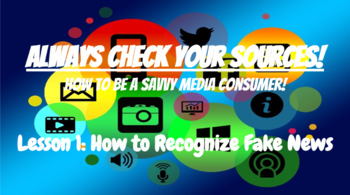Propaganda and Media Literacy Complete Unit and Group Project
Lexiphile
23 Followers
Grade Levels
6th - 12th, Homeschool
Resource Type
Standards
CCSSCCRA.R.1
CCSSCCRA.R.6
CCSSCCRA.R.8
CCSSRH.6-8.1
CCSSRH.6-8.6
Formats Included
- Google Slides™
Pages
52 pages
Lexiphile
23 Followers

Made for Google Drive™
This resource can be used by students on Google Drive or Google Classroom. To access this resource, you’ll need to allow TPT to add it to your Google Drive. See our FAQ and Privacy Policy for more information.
Description
This is a complete mini-unit on specific Propaganda techniques and ways to spot them in media and advertising. Students see examples, discuss questions with a partner, write down their ideas, and take guided notes.
Included in this package:
- Complete presentation "Lesson 1: How to Spot Fake News"
- Complete presentation "Lesson 2: Propaganda Techniques"
- Printable Student Guided Notes for Lesson 2 presentation
- Song lyrics: "Can't Trust This Source Yet" (to the tune of "Can't Stop the Feeling" by Justin Timberlake)
- Instructions, rubric, and template for group project (Can be a Google Slides presentation or a physical poster)
Total Pages
52 pages
Answer Key
N/A
Teaching Duration
1 Week
Report this resource to TPT
Reported resources will be reviewed by our team. Report this resource to let us know if this resource violates TPT’s content guidelines.
Standards
to see state-specific standards (only available in the US).
CCSSCCRA.R.1
Read closely to determine what the text says explicitly and to make logical inferences from it; cite specific textual evidence when writing or speaking to support conclusions drawn from the text.
CCSSCCRA.R.6
Assess how point of view or purpose shapes the content and style of a text.
CCSSCCRA.R.8
Delineate and evaluate the argument and specific claims in a text, including the validity of the reasoning as well as the relevance and sufficiency of the evidence.
CCSSRH.6-8.1
Cite specific textual evidence to support analysis of primary and secondary sources.
CCSSRH.6-8.6
Identify aspects of a text that reveal an author’s point of view or purpose (e.g., loaded language, inclusion or avoidance of particular facts).


